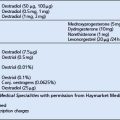CHAPTER 11 RESPIRATORY MEDICINE
ASTHMA
Asthma is a common chronic disease affecting approximately 5% of adults and 15% of children (see p. 94). It is a disease characterised by increased responsiveness of the airways to a variety of stimuli. The clinical picture is one of wheezing, coughing or shortness of breath, often worse at night. The following is based on the 2005 update of the British Thoracic Society Guidelines for Asthma first published in Thorax in 2003.
CHRONIC ASTHMA
Diagnosis
History.
The suspicion of asthma should be raised if there is a history of chronic recurrent cough or wheeze.
Examination/peak flow data
Management
Advice
Management principles
Drug therapy (for older children and adults)
Step four.
Self-management plan.
ACUTE ASTHMA
Many asthma deaths are preventable. Factors include:
Diagnosis
Management
Lower the threshold for admission if:
Treatment
UPPER RESPIRATORY TRACT INFECTION (URTI)
Upper respiratory tract infections are responsible for about 30% of all GP consultations.
ACUTE COUGH
Other symptoms suggest an alternative diagnosis:
Management
CHRONIC COUGH
Diagnosis
History.
Many adults, however, fall into the category of chronic cough with no obvious associated features.
Examination.
Chest examination may give some clues, but is often normal in patients with a chronic cough.
CHEST INFECTION
Diagnosis
Management
PNEUMONIA
Diagnosis
Management
HAEMOPTYSIS
Diagnosis
CHRONIC OBSTRUCTIVE PULMONARY DISEASE (COPD)
Diagnosis
History.
COPD should be considered in adults with persistent cough, sputum production or shortness of breath.
Investigations
Management
Acute exacerbation of COPD
An acute exacerbation is a short-term worsening of symptoms, usually caused by infection.




